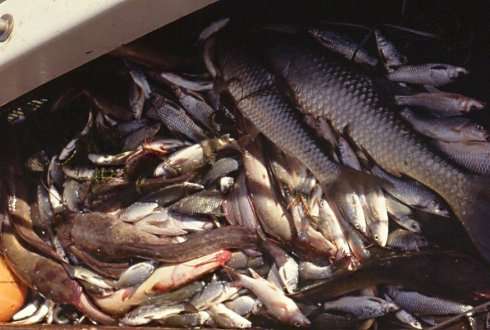Fish species in Lake Tana genetically surprisingly similar

The different species of barbels in Lake Tana in northern Ethiopia have evolved from a common ancestor. When biologists from Wageningen University first described the fifteen species over twenty years ago, it was not yet possible to examine the precise genetic differences between these carp species. Now, together with a colleague from Portugal, they have mapped the genetic basis of the diversity. Their work has been published in the Journal of Fish Biology.
Lake Tana in the northern highlands of Ethiopia contains a group of carp-like fishes. In the nineties, these barbels attracted attention because of the emerging fishery in the lake. During research into the possibilities for sustainable fishery, biologists from Wageningen and Ethiopia found that these species occur nowhere else.
Speciation
Lake Tana was formed by volcanic damming of the Blue Nile. The ancestral species that lived in the river, has probably diverged into at least fifteen different species within the lake. This species flock can only have originated after the last ice age, because then the lake was completely dried up and only the Blue Nile itself and some small rivers contained water. That means that the speciation took place in no more than 13 thousand years: extremely fast for evolutionary developments. The species differ greatly in size (adult animals vary from less than 20 centimetres to about one meter), in form (with long narrow bodies and large mouths, but also with flattened bodies and small mouths), in their diet (ranging from plants to snails and even other fish) and in their reproductive behaviour (in different parts of small rivers that enter the lake or in the lake itself). At that time it was not possible to investigate the genetic basis of this diversity in detail, due to technical constraints.
Closely related
By using modern DNA techniques, the genetics of the Tana barbels have been partly clarified. Throughout the whole lake tissue samples have been collected systematically. These have been analysed by a collaboration of researchers from Wageningen from Aquaculture and Fisheries, Experimental Zoology, the Animal Breeding and Genomics Centre and IMARES, together with the Centre of Marine Sciences in Portugal. This analysis shows that the total genetic variation is very limited, which was also determined for the famous cichlids in Lake Victoria.
Barbels that differ greatly in appearance and consume different kinds of food are genetically most distinct. This supports the scenario that the speciation has occurred in Lake Tana due to the various species of fish each specializing into their own ecological niche.
Field work essential
The study shows that it is not easy to determine whether fish belong to different species on genetic grounds alone. The study of other characteristics, such as appearance and ecology, but also behaviour in their natural habitat, thus remains essential.
More information: L. A. J. Nagelkerke et al. "Shallow genetic divergence and species delineations in the endemic species flock of Lake Tana, Ethiopia," Journal of Fish Biology (2015). DOI: 10.1111/jfb.12779
Journal information: Journal of Fish Biology , Fisheries
Provided by Wageningen University
















